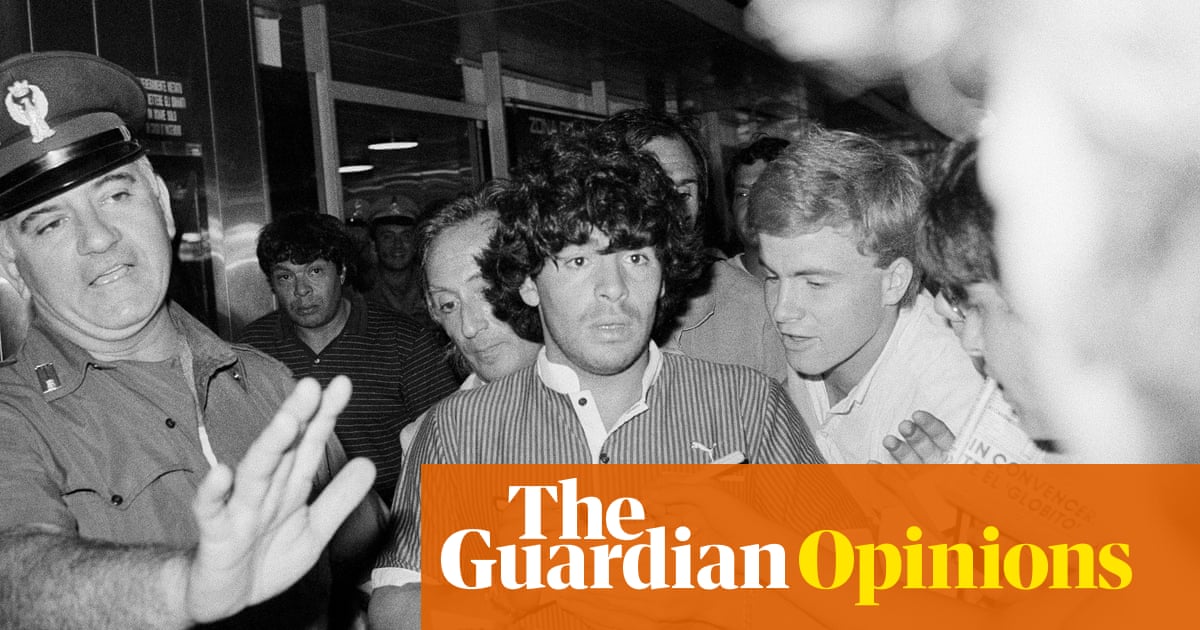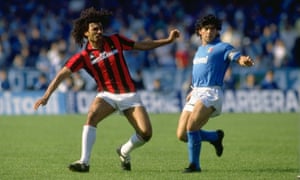The Argentinian greats Napoli years, chronicled in Asif Kapadias latest, show real pressures of adulation compared to todays walled-away talents

When I sat down in a cinema to watch Emir Kusturicas documentary about Diego Maradona a decade or so ago, I still thought of myself as a Pel man. The Brazilian was the footballer who had dominated my adolescence, which is usually the time of life at which we acquire the heroes to whom we remain in thrall. Kusturicas film made me reconsider that loyalty. He made me think that those who believed Maradona was the greatest footballer of all time might have a point.
It was a mad film about a mad life, starting with a quote from Jorge Luis Borges and finishing with a song from Manu Chao. There was a lot of weird stuff in between. But the Serbian director also included enough football to persuade me that Maradona bent matches to his will in the way no one had done before, and that if we were trying to decide on the very greatest, a stupid but fun thing to do, then this might be the truest measure.
Asif Kapadias new film about Maradona, which opened last week, makes me think again. The director of documentaries about Ayrton Senna and Amy Winehouse chooses to concentrate on a particular period of the players career, his years with Napoli, which included the 1986 World Cup in which he led Argentina to victory. The before and the after from the childhood in a Buenos Aires slum and the ill-fated arrival in Europe with Barcelona to the bitter defeat to West Germany at San Siro in 1990 and the pathos of his late middle age are also included. But what happened to him from 1984 to 1991, between the ages of 23 and 30, is the only real focus, and Kapadia makes it seem brutally short.
As an admirer of the directors immersive approach to documentary-making, I found it a little overcooked. A film that begins with a lunatic car journey through the streets of Naples seldom takes its foot off the throttle. You could argue that Maradonas life was like that, but it wouldnt be entirely true. Nor was the football he played a constant barrage of thud and crunch, as Kapadia and his sound-effects team make it seem. There was poetry as well as percussion in there, although the director is right to link the two goals against England in the Azteca to the appalling smash to Maradonas face delivered by Terry Fenwick did he really play for England, or was it just a bad dream? earlier in the match.
Kusturica found some poetry when he led the footballer out of a people-carrier and confronted him with Manu Chao leaning against a storefront, strumming a guitar and singing a song about his life: If I were Maradona / I would live like him Maradonas eyes are hidden, but you can sense the play of emotions behind his wraparound shades as he listens to Chao sing about a life of a thousand rockets, a thousand friends.

That life is Kapadias subject, and what he captures quite brilliantly is the unsustainable pressure exerted by the sort of adulation Maradona encountered in Naples, an endless physical assault by people wanting to touch him, to be in a photograph with him, to take away a piece of him. Those people crowd the frames of the film, eroding his soul almost as effectively as the Camorra bosses who spotted his weaknesses.
His swift and premature downfall has never held back those to whom he ranks highest in a list including not just Pel but Ferenc Pusks, Alfredo di Stfano, Franz Beckenbauer, George Best, Johan Cruyff, Lionel Messi and Cristiano Ronaldo. Each has, or had, his own special story. Pusks crossed the iron curtain at the height of the cold war. Di Stfano represented a certain regal presence. Pel expressed the triumph of individual invention. Beckenbauer showed us how a defender could construct the play of the entire team. Best the closest in several ways to Maradona was untameable. Cruyff saw the whole thing, and knew how to reshape it.
And now we have the two stars whose decade-long duel has offered such a study in contrast: Messi expressing his virtuosity with a unique air of humility, taking a goal of breathtaking execution with the air of a servant swigging a glass of vintage champagne, Ronaldo deploying his ego as an extra piece of technical equipment, forcing opponents to shrivel in the heat of his personal spotlight. For me, now, it is Ronaldo, inventing new ways of striking the ball while triumphing in England, Spain and Italy and with his national team, who stands supreme. And you dont have to like him to acknowledge that.
Ronaldo, Messi and others of their generation know all about what happened to Maradona, how fame devoured him. His example, burnt into every frame of Kapadias film, is the reason they are now such remote figures. No footballer earning upwards of a quarter of a million pounds a week is short of instruction on how to build the walls, physical and psychological, with which to protect themselves against their worshippers.
A few hours after seeing the new film, I read an interview in these pages in which Phil Foden, a 19-year-old Manchester City and England star in the making, talked about his first experience of celebrity. People are always watching you, he said. Its what happens. I was walking down the road after one of my first games and people were asking for a picture. From that moment I knew it was going to be hard. Already he probably understands the meaning of Maradonas most poignant words in Kapadias film: When youre on the pitch, life goes away. Everything goes away.
Read more: http://www.theguardian.com/us


